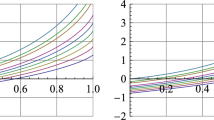Abstract
A classical theorem of Bôcher says a positive harmonic function on a punctured domain \(\mathcal {O}\setminus p\) in Euclidean space can be written as the sum of a constant multiple of the Green function with pole at p and a function harmonic on all of \(\mathcal {O}\). Here we establish such a result in the setting of functions on a Riemannian manifold with rather rough metric tensor.
Similar content being viewed by others
References
Axler, S., Bourdon, P., Ramey, W.: Bôcher’s theorem, Amer. Math. Monthly 99, 51–55 (1992)
Axler, S., Bourdon, P., Ramey, W.: Harmonic Function Theory. Springer-Verlag, New York (1992)
Bôcher, M.: Singular points of functions which satisfy partial differential equations of the elliptic type. Bull. AMS 9, 455–465 (1903)
Calderón, A.P.: Algebras of singular integral operators. AMS Proc. Symp. Pure Math. X, 10 pp 18–55 (1967)
Choe, B.R.: Bôcher’s theorem for \({\mathscr{M}}\)-harmonic functions. Houston J. Math. 18, 539–549 (1992)
Eidel’man, S., Pletneva, T.: Bôcher’s theorem for positive solutions of elliptic equations of arbitrary order. Mat. Isled. 8, 173–177 (1973). (In Russian)
Gilbarg, D., Trudinger, N.: Elliptic Partial Differential Equations of Second Order, Springer, New York 1977 (2nd ed. (1983)
Grüter, M., Widman, K.-O.: The Green function for uniformly elliptic equations. Manuscripta Math. 37, 303–342 (1982)
Helms, L.: Introduction to Potential Theory. Wiley-Interscience, New York (1969)
Kondrat’ev, V., Eidel’man, S.: Positive solutions of linear partial differential equations. Trudy Moskov Math. Obsc. 31, 85–146 (1974)
Ligocka, E.: Elementary proofs of the Liouville and bôcher theorems for polyharmonic functions. Annale Polonici Math. 68, 257–265 (1998)
Marschall, J.: Pseudo-differential operators with coefficients in Sobolev spaces. Trans AMS 307, 335–361 (1988)
Marschall, J.: Parametrices for nonregular pseudodifferential operators. Math. Nachr. 159, 175–188 (1992)
Mitrea, M., Taylor, M.: Potential theory on Lipschitz domains in Riemannian manifolds: hölder continuous metric tensors. Commun PDE 25, 1487–1536 (2000)
Mitrea, M., Taylor, M.: Potential theory on Lipschitz domains in Riemannian manifolds: the case of Dini metric tensors. Trans AMS 355, 1961–1985 (2003)
Taylor, M.: Partial Differential Equations, Vols. 1–3, Springer-Verlag, New York 1996 (2nd ed. (2011)
Taylor, M.: Pseudodifferential Operators and Nonlinear PDE, Birkhauser boston (1991)
Taylor, M.: Tools for PDE – Pseudodifferential operators, Paradifferential operators, and Layer potentials, Amer. Math. Soc. Providence RI (2000)
Author information
Authors and Affiliations
Corresponding author
Additional information
Publisher’s Note
Springer Nature remains neutral with regard to jurisdictional claims in published maps and institutional affiliations.
Work partially supported by NSF grant DMS-1500817.
Rights and permissions
About this article
Cite this article
Taylor, M. Bôcher’s Theorem with Rough Coefficients. Potential Anal 56, 65–86 (2022). https://doi.org/10.1007/s11118-020-09876-y
Received:
Accepted:
Published:
Issue Date:
DOI: https://doi.org/10.1007/s11118-020-09876-y




